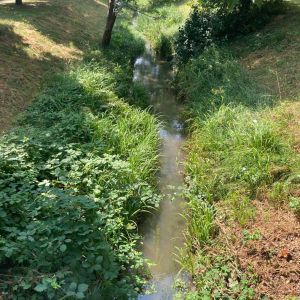The Role of Rivers: Conference of the CE Theoretical Archaeology Group in Bratislava.
By Julia Längauer
The CE TAG (Central European Theoretical Archaeology Group) conference in Bratislava from November 9th to 10th, focusing on "The Role of Rivers: Frontiers, mobility corridors, or central place ecosystems", provided an international platform for researchers to discuss their latest findings. Julia Längauer presented a lecture at the conference on behalf of the "United by Crisis?"-project, discussing the role of rivers in the northern Weinviertel and their literal influence on the settlement dynamics of the Linearbandkeramik 7000 years ago.
Rivers as Lifelines and Trade Routes
Rivers served not only as vital sources of water but also as trade and contact routes. In a time when trade began to play an increasingly important role in society, rivers evolved into extensively used connections between settlements, even to distant areas like the region around Lake Balaton. The inhabitants of the northern Weinviertel utilized the waterways of the region for trade and resource exchange. This access to goods from other regions facilitated an early economic boom, evidenced by imports found in archaeological discoveries.
Rivers as Resource Suppliers
Another crucial aspect was the function of rivers as local resource suppliers. People 7000 years ago were heavily reliant on natural resources, and rivers provided fertile land for agriculture as well as a rich variety of fish and other natural goods, such as beaver pelts and even river mussels. In the Linearbandkeramik, these mussels served not only as food but also as storage containers for tinder materials for fire-making. Evidence of these tinder boxes is found in Linearbandkeramik graves, where flint, pyrite, and the shells of river mussels were discovered. Thus, rivers were not only transportation routes but also vital sources for the local economy.
Natural Boundaries and Settlement Clusters
Interestingly, rivers also seem to have served as natural boundaries, probably delineating neighbouring settlement clusters. The residents of the northern Weinviertel recognized the strategic importance of rivers and streams as landmarks for setting boundaries, contributing to the formation of settlement chambers closely associated with these natural boundaries.
Linearbandkeramik and the development of a Central Place along the Zaya River
The focal point of the presentation was the development of the Linearbandkeramik central site of Asparn/Schletz along the Zaya River. Although the Zaya may not carry much water today, it was likely a more substantial river in the Neolithic era due to the moister climatic conditions. Through the March and Danube, the Zaya facilitated contact with other regions, as reflected in the archaeological findings mentioned earlier. The people of that time established a central hub that flourished not only due to its geographical advantages but also because of its direct connection to the river. This central place became the core and starting point of cultural and economic activities, emphasizing the significance of rivers in the development of communities.
Conclusion
Rivers and streams in the Linearbandkeramik were much more than simple water sources. They served as lifelines, trade routes, resource suppliers, and natural boundaries, significantly influencing the development of the settlement landscape in the northern Weinviertel 7000 years ago. These findings underscore the adept use of natural conditions in building the first agricultural and pastoral communities on Austrian soil.




